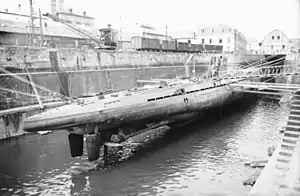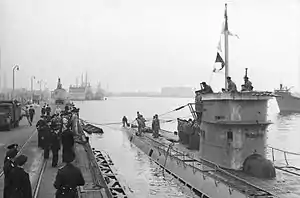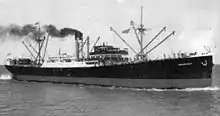German submarine U-37 (1938)
German submarine U-37 was a Type IXA[3] U-boat of the German Navy (Kriegsmarine) during World War II.[1] The submarine was laid down on 15 March 1937 at the DeSchiMAG AG Weser yard in Bremen, launched on 14 May 1938, and commissioned on 4 August 1938 under the command of Kapitänleutnant Heinrich Schuch as part of the 6th U-boat Flotilla.[1]
 U-37 at Lorient in 1940 | |
| History | |
|---|---|
| Name | U-37 |
| Ordered | 29 July 1936 |
| Builder | DeSchiMAG AG Weser, Bremen |
| Yard number | 942 |
| Laid down | 15 March 1937 |
| Launched | 14 May 1938 |
| Commissioned | 4 August 1938 |
| Fate | Scuttled, 8 May 1945 |
| General characteristics | |
| Class and type | Type IXA submarine |
| Displacement |
|
| Length |
|
| Beam |
|
| Height | 9.40 m (30 ft 10 in) |
| Draught | 4.70 m (15 ft 5 in) |
| Installed power |
|
| Propulsion |
|
| Speed |
|
| Range |
|
| Test depth | 230 m (750 ft) |
| Complement | 4 officers, 44 enlisted |
| Armament |
|
| Service record[1][2] | |
| Part of: |
|
| Commanders: |
|
| Operations: |
|
| Victories: | |
Between August 1939 and March 1941, U-37 conducted eleven combat patrols, sinking 53 merchant ships, for a total of 200,063 gross register tons (GRT); and two warships, the British Hastings-class sloop HMS Penzance, and the French submarine Sfax (Q182).[1] U-37 was then withdrawn from front-line service and assigned to training units until the end of the war. On 8 May 1945 the U-boat was scuttled in Sonderburg Bay, off Flensburg.[1] U-37 was the sixth most successful U-boat in World War II.[4]
Design
As one of the eight original German Type IX submarines, later designated IXA, U-37 had a displacement of 1,032 tonnes (1,016 long tons) when at the surface and 1,153 tonnes (1,135 long tons) while submerged.[5] The U-boat had a total length of 76.50 m (251 ft), a pressure hull length of 58.75 m (192 ft 9 in), a beam of 6.51 m (21 ft 4 in), a height of 9.40 m (30 ft 10 in), and a draught of 4.70 m (15 ft 5 in). The submarine was powered by two MAN M 9 V 40/46 supercharged four-stroke, nine-cylinder diesel engines producing a total of 4,400 metric horsepower (3,240 kW; 4,340 shp) for use while surfaced, two Siemens-Schuckert 2 GU 345/34 double-acting electric motors producing a total of 1,000 metric horsepower (740 kW; 990 shp) for use while submerged. She had two shafts and two 1.92 m (6 ft) propellers. The boat was capable of operating at depths of up to 230 metres (750 ft).[5]
The submarine had a maximum surface speed of 18.2 knots (33.7 km/h; 20.9 mph) and a maximum submerged speed of 7.7 knots (14.3 km/h; 8.9 mph).[5] When submerged, the boat could operate for 65–78 nautical miles (120–144 km; 75–90 mi) at 4 knots (7.4 km/h; 4.6 mph); when surfaced, she could travel 10,500 nautical miles (19,400 km; 12,100 mi) at 10 knots (19 km/h; 12 mph). U-37 was fitted with six 53.3 cm (21 in) torpedo tubes (four fitted at the bow and two at the stern), 22 torpedoes, one 10.5 cm (4.13 in) SK C/32 naval gun, 180 rounds, and a 3.7 cm (1.5 in) as well as a 2 cm (0.79 in) C/30 anti-aircraft gun. The boat had a complement of forty-eight.[5]
Service history
First patrol
U-37 left Wilhelmshaven, with Kapitänleutnant Heinrich Schuch in command, on 19 August 1939. The boat operated for nearly four weeks in the North Atlantic, returning to port on 15 September 1939.[6]
Second patrol
U-37 left Wilhelmshaven on 5 October 1939 to conduct operations in the North Atlantic now under the command of Korvettenkapitän Werner Hartmann. During this patrol she sank eight ships: four British, two Greek, one French and one Swedish, including the British steam freighter Yorkshire which was traveling with the Allied convoy HG-3, sailing from Gibraltar to Liverpool, England. Hartmann returned his boat to port on 8 November after nearly five weeks at sea.[7]
Third patrol
On 1 January 1940 U-37 was reassigned to the 2nd U-boat Flotilla based at Wilhelmshaven. On 28 January 1940 the U-boat departed for the North Atlantic, with Werner Hartmann in command. As on his previous patrol, Hartmann sank eight ships, this time three British, two Norwegian, one Danish, one French and one Greek. Of these ships, two were in convoy at the time. U-37 returned to Wilhelmshaven on 27 February.[8]

Fourth patrol

U-37 departed Wilhelmshaven on 30 March for Werner Hartmann's third consecutive patrol, this time around Norway. Again, Hartmann proved successful, sinking three ships; the Norwegian Tosca, the Swedish Sveaborg and the British Stancliffe. After patrolling for over two weeks, the U-boat returned to Wilhelmshaven on 18 April.[9]
Fifth patrol
Under a new captain, Kapitänleutnant Victor Oehrn, U-37 departed from Wilhelmshaven on 15 May for a patrol around Portugal and Spain. U-37 had her most successful mission, hitting eleven ships, sinking ten of them. Three French ships were sunk, two Greek, two British, one Swedish, one Argentinian, one Finnish; one British ship was damaged. After three and a half weeks at sea, U-37 returned to Wilhelmshaven on 9 June.[10]
The neutral Argentinian ship was Uruguay, sailing from Rosario to Limerick with a cargo of maize. U-37 surfaced and stopped Uruguay and examined her papers, then sank her with scuttling charges. Her crew of 28 were left in their lifeboats. Fifteen died, 13 survived.[11]

Sixth patrol
U-37 sailed from Wilhelmshaven on 1 August, again with Victor Oehrn in command. This week and a half long patrol in the Atlantic off the west coast of Ireland resulted in the sinking of a single British ship, Upwey Grange. U-37 returned to port on 12 August, but rather than head back to Wilhelmshaven, she made for Lorient in France, where the 2nd U-boat Flotilla was now based.[12]
Seventh patrol
For the first time, U-37 began a patrol from a location other than Germany, in Lorient on 17 August, with Victor Oehrn in command once more. It was to focus on operations off the south-west coast of Ireland. Seven ships were sunk during this voyage; five of which were British, one Norwegian, and one Greek. Of these ships, one was from convoy OA 220, the British Brookwood, traveling from Britain to the Australia, two were from convoy SC 1, the British sloop HMS Penzance (L28) and Blarimore, sailing from Sydney, Nova Scotia, Canada, to the United Kingdom. After two weeks at sea, U-37 returned to Lorient on 30 August.[13]
Eighth patrol
On 24 September, U-37 departed Lorient on Victor Oehrn's fourth patrol, in which he would sail to the North Atlantic. During this month-long operation U-37 sank six ships, four of which were in convoy at the time of attack, all of which were British. Five of these six ships were sailing under the British flag, while the sixth was from Egypt. The British ship Corrientes was sunk as part of OB-217, sailing from Liverpool to North America. Heminge was sailing as part of OB-220, also sailing from Liverpool to North America. British General was sunk while sailing as part of convoy OA 222, sailing from Britain to North America. The fourth ship sunk was the British Stangrant, sailing as part of convoy HX 77 from Halifax to the United Kingdom. The U-boat returned to Lorient on 22 October.[14]
Ninth patrol
After over a month in port, U-37 departed with a new captain, Oberleutnant zur See Asmus Nicolai Clausen on 28 November for operations around north-west Africa and Spain. Seven ships were sunk during this patrol; two French, two Swedish, two British and one Spanish. Of these seven ships, three were in convoy at the time of their sinking. The Swedish Gwalia and Daphne and the British Jeanne M were sailing as part of convoy OG 46 from Britain to Gibraltar. The French vessels, the oiler Rhône and the submarine Sfax belonged to Vichy France and were sunk in error. After five weeks on the high seas, U-37 returned to Lorient on 14 January 1941.[15]
Tenth and eleventh patrols
U-37 left Lorient on 30 January 1941 to patrol off the coast of Portugal. On 8 February she spotted Convoy HG-53. The next day, U-37 sank two British ships, Courland and Estrellano. The third merchant vessel that U-37 sank on her tenth patrol was the British ship Brandenburg, on 10 February. The U-boat then returned to Lorient on 18 February after spending 20 days at sea and sinking 4,781 GRT of shipping.[16]
Leaving Lorient for the final time on 27 February 1941, U-37's last patrol took her to the waters south of Iceland. There she sank two vessels, the Greek cargo ship Mentor on 7 March, and the Icelandic trawler Pétursey on the 12th. After spending 24 days at sea, U-37 entered the port of Kiel on 22 March.[17]
Training boat
On 1 May 1941 U-37 was reassigned to the 26th U-boat Flotilla, based at Pillau (now Baltiysk, Russia) as a training U-boat. She was transferred to the 22nd U-boat Flotilla, based at Gotenhafen (now Gdynia, Poland) on 1 April 1942, and finally to the 4th U-boat Flotilla on 1 July 1944, where she remained until the end of the war.
She was scuttled by her crew on 8 May 1945.[1]
Film Portrayals
The British war propaganda film 49th Parallel (1941) uses the name U-37 for the German submarine whose crew comes ashore in Canada during WW2. The craft is shown being blown up in Hudson Bay. The film was released shortly after the real U-37 was removed from active service.
In the 1943 war film Action in the North Atlantic, the U-boat in the opening scenes is titled U-37.
Summary of raiding history
| Date | Name of Ship | Nationality | Tonnage[Note 1] | Fate[18] |
|---|---|---|---|---|
| 8 October 1939 | Vistula | 1,018 | Sunk | |
| 12 October 1939 | Aris | 4,810 | Sunk | |
| 15 October 1939 | Vermont | 5,186 | Sunk | |
| 17 October 1939 | Yorkshire | 10,183 | Sunk | |
| 24 October 1939 | Ledbury | 3,528 | Sunk | |
| 24 October 1939 | Menin Ridge | 2,474 | Sunk | |
| 24 October 1939 | Tafna | 4,413 | Sunk | |
| 30 October 1939 | Thrasyvoulos | 3,693 | Sunk | |
| 4 February 1940 | Hop | 1,365 | Sunk | |
| 4 February 1940 | Leo Dawson | 4,330 | Sunk | |
| 10 February 1940 | Silja | 1,259 | Sunk | |
| 11 February 1940 | Togimo | 290 | Sunk | |
| 15 February 1940 | Aase | 1,206 | Sunk | |
| 17 February 1940 | Pyrrhus | 7,418 | Sunk | |
| 18 February 1940 | Elin | 4,917 | Sunk | |
| 18 February 1940 | P.L.M. 15 | 3,754 | Sunk | |
| 10 April 1940 | Sveaborg | 9,076 | Sunk | |
| 10 April 1940 | Tosca | 5,128 | Sunk | |
| 12 April 1940 | Stancliffe | 4,511 | Sunk | |
| 19 May 1940 | Erik Frisell | 5,066 | Sunk | |
| 22 May 1940 | Dunster Grange | 9,494 | Damaged | |
| 24 May 1940 | Kyma | 3,994 | Sunk | |
| 27 May 1940 | Sheaf Mead | 5,008 | Sunk | |
| 27 May 1940 | Uruguay | 3,425 | Sunk | |
| 28 May 1940 | Brazza | 10,387 | Sunk | |
| 28 May 1940 | Julien | 116 | Sunk | |
| 28 May 1940 | Maria Rosé | 2,477 | Sunk | |
| 29 May 1940 | Telena | 7,406 | Sunk | |
| 1 June 1940 | Ioanna | 950 | Sunk | |
| 3 June 1940 | Snabb | 2,317 | Sunk | |
| 8 August 1940 | Upwey Grange | 9,130 | Sunk | |
| 22 August 1940 | Keret | 1,718 | Sunk | |
| 23 August 1940 | Severn Leigh | 5,242 | Sunk | |
| 24 August 1940 | Brookwood | 5,100 | Sunk | |
| 24 August 1940 | HMS Penzance | 1,025 | Sunk | |
| 25 August 1940 | Blairmore | 4,141 | Sunk | |
| 25 August 1940 | Yewcrest | 3,774 | Sunk | |
| 27 August 1940 | Theodoros T | 3,409 | Sunk | |
| 27 September 1940 | Georges Mabro | 2,555 | Sunk | |
| 28 September 1940 | Corrientes | 6,863 | Sunk | |
| 30 September 1940 | Heminge | 2,499 | Sunk | |
| 30 September 1940 | Samala | 5,390 | Sunk | |
| 6 October 1940 | British General | 6,989 | Sunk | |
| 13 October 1940 | Stangrant | 5,804 | Sunk | |
| 1 December 1940 | Palmella | 1,578 | Sunk | |
| 2 December 1940 | Gwalia | 1,258 | Sunk | |
| 2 December 1940 | Jeanne M. | 2,465 | Sunk | |
| 4 December 1940 | Daphne | 1,513 | Sunk | |
| 16 December 1940 | San Carlos | 223 | Sunk | |
| 19 December 1940 | Rhône | 2,785 | Sunk | |
| 19 December 1940 | Sfax (Q 182) | 1,379 | Sunk | |
| 9 February 1941 | Courland | 1,325 | Sunk | |
| 9 February 1941 | Estrellano | 1,983 | Sunk | |
| 10 February 1941 | Brandenburg | 1,473 | Sunk | |
| 7 March 1941 | Mentor | 3,050 | Sunk | |
| 12 March 1941 | Petursey | 91 | Sunk |
References
Notes
- Merchant ship tonnages are in gross register tons. Military vessels are listed by tons displacement.
Citations
- Helgason, Guðmundur. "The Type IXA boat U-37". German U-boats of WWII - uboat.net. Retrieved 21 March 2010.
- Helgason, Guðmundur. "War Patrols by German U-boat U-37". German U-boats of WWII - uboat.net. Retrieved 21 March 2010.
- Helgason, Guðmundur. "Type IXA". German U-boats of WWII - uboat.net. Retrieved 29 March 2010.
- Helgason, Guðmundur. "The Most Successful U-boats". German U-boats of WWII - uboat.net. Retrieved 29 March 2010.
- Gröner 1991, p. 68.
- Helgason, Guðmundur. "Patrol info for U-37 (First patrol)". German U-boats of WWII - uboat.net. Retrieved 21 March 2010.
- Helgason, Guðmundur. "Patrol info for U-37 (Second patrol)". German U-boats of WWII - uboat.net. Retrieved 21 March 2010.
- Helgason, Guðmundur. "Patrol info for U-37 (Third patrol)". German U-boats of WWII - uboat.net. Retrieved 21 March 2010.
- Helgason, Guðmundur. "Patrol info for U-37 (Fourth patrol)". German U-boats of WWII - uboat.net. Retrieved 21 March 2010.
- Helgason, Guðmundur. "Patrol info for U-37 (Fifth patrol)". German U-boats of WWII - uboat.net. Retrieved 30 March 2010.
- Helgason, Guðmundur. "Uruguay (Steam merchant)". German U-boats of WWII - uboat.net. Retrieved 21 March 2010.
- Helgason, Guðmundur. "Patrol info for U-37 (Sixth patrol)". German U-boats of WWII - uboat.net. Retrieved 21 March 2010.
- Helgason, Guðmundur. "Patrol info for U-37 (Seventh patrol)". German U-boats of WWII - uboat.net. Retrieved 21 March 2010.
- Helgason, Guðmundur. "Patrol info for U-37 (Eighth patrol)". German U-boats of WWII - uboat.net. Retrieved 21 March 2010.
- Helgason, Guðmundur. "Patrol info for U-37 (Ninth patrol)". German U-boats of WWII - uboat.net. Retrieved 21 March 2010.
- Helgason, Guðmundur. "Patrol info for U-37 (Tenth patrol)". German U-boats of WWII - uboat.net. Retrieved 21 March 2010.
- Helgason, Guðmundur. "Patrol info for U-37 (Eleventh patrol)". German U-boats of WWII - uboat.net. Retrieved 21 March 2010.
- Helgason, Guðmundur. "Ships hit by U-37". German U-boats of WWII - uboat.net. Retrieved 17 February 2015.
Bibliography
- Busch, Rainer; Röll, Hans-Joachim (1999). German U-boat commanders of World War II : a biographical dictionary. Translated by Brooks, Geoffrey. London, Annapolis, Md: Greenhill Books, Naval Institute Press. ISBN 1-55750-186-6.
- Gröner, Erich; Jung, Dieter; Maass, Martin (1991). U-boats and Mine Warfare Vessels. German Warships 1815–1945. Vol. 2. Translated by Thomas, Keith; Magowan, Rachel. London: Conway Maritime Press. ISBN 0-85177-593-4.
External links
- Helgason, Guðmundur. "The Type IXA boat U-37". German U-boats of WWII - uboat.net. Retrieved 21 March 2010.
- Hofmann, Markus. "U 37". Deutsche U-Boote 1935-1945 - u-boot-archiv.de (in German). Retrieved 7 December 2014.
- "U-boat Archive - U-boat KTB - U-37 2nd War Patrol". Retrieved 13 April 2017.
- UFA Newsreel of Werner Hartmann and U-37 in 1940 (in German)